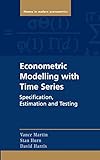Econometric modelling with time series : specification, estimation and testing / Vance Martin, University of Melbourne, Australia, Stan Hurn, Queensland University of Technology, Australia, David Harris, Monash University, Australia.
Material type: TextSeries: Themes in modern econometricsDescription: xxxv, 887 pages : illustrations ; 25 cmISBN:
TextSeries: Themes in modern econometricsDescription: xxxv, 887 pages : illustrations ; 25 cmISBN: - 9780521196604 (hardback)
- 9780521139816 (paperback)
- 330.01/51955 23
- HB141 .M3555 2013
- BUS061000
| Item type | Current library | Call number | Copy number | Status | Date due | Barcode |
|---|---|---|---|---|---|---|
 General Books
General Books
|
CUTN Central Library Sciences | 330.01/51955 (Browse shelf(Opens below)) | 1 | Available | 19086 |
Includes bibliographical references (pages 865-876) and indexes.
Machine generated contents note: Part I. Maximum Likelihood: 1. The maximum likelihood principle; 2. Properties of maximum likelihood estimators; 3. Numerical estimation methods; 4. Hypothesis testing; Part II. Regression Models: 5. Linear regression models; 6. Nonlinear regression models; 7. Autocorrelated regression models; 8. Heteroskedastic regression models; Part III. Other Estimation Methods: 9. Quasi-maximum likelihood estimation; 10. Generalized method of moments; 11. Nonparametric estimation; 12. Estimation by stimulation; Part IV. Stationary Time Series: 13. Linear time series models; 14. Structural vector autoregressions; 15. Latent factor models; Part V. Non-Station Time Series: 16. Nonstationary distribution theory; 17. Unit root testing; 18. Cointegration; Part VI. Nonlinear Time Series: 19. Nonlinearities in mean; 20. Nonlinearities in variance; 21. Discrete time series models; Appendix A. Change in variable in probability density functions; Appendix B. The lag operator; Appendix C. FIML estimation of a structural model; Appendix D. Additional nonparametric results.
"This book provides a general framework for specifying, estimating, and testing time series econometric models"--
"Maximum likelihood estimation is a general method for estimating the parameters of econometric models from observed data. The principle of maximum likelihood plays a central role in the exposition of this book, since a number of estimators used in econometrics can be derived within this framework. Examples include ordinary least squares, generalized least squares and full-information maximum likelihood. In deriving the maximum likelihood estimator, a key concept is the joint probability density function (pdf) of the observed random variables, yt. Maximum likelihood estimation requires that the following conditions are satisfied. (1) The form of the joint pdf of yt is known. (2) The specification of the moments of the joint pdf are known. (3) The joint pdf can be evaluated for all values of the parameters, 9. Parts ONE and TWO of this book deal with models in which all these conditions are satisfied. Part THREE investigates models in which these conditions are not satisfied and considers four important cases. First, if the distribution of yt is misspecified, resulting in both conditions 1 and 2 being violated, estimation is by quasi-maximum likelihood (Chapter 9). Second, if condition 1 is not satisfied, a generalized method of moments estimator (Chapter 10) is required. Third, if condition 2 is not satisfied, estimation relies on nonparametric methods (Chapter 11). Fourth, if condition 3 is violated, simulation-based estimation methods are used (Chapter 12). 1.2 Motivating Examples To highlight the role of probability distributions in maximum likelihood estimation, this section emphasizes the link between observed sample data and 4 The Maximum Likelihood Principle the probability distribution from which they are drawn"--


There are no comments on this title.